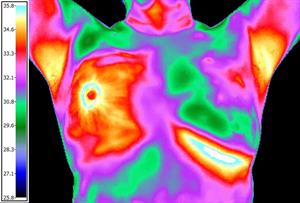Breast Cancer Screening with Medical Thermology
July 18, 2017 | Author: Philip Hoekstra, PhD
Forty years after the declaration of the War on Cancer, breast cancer is the most common form of cancer for women and second only to lung cancer as the leading cause of cancer death.1, 2 Forty-five years of research and $90 billion spent by the US National Cancer Institute alone have produced new treatments that save lives, but most of these treatments are effective only with early detection.3 Women need to start screening in their forties to achieve life-saving early detection, and mammography just isn’t very effective until menopause decreases breast density.4
The prevailing screening programs haven’t demonstrated any ability to save women’s lives because of an over-reliance on mammography and are facing elimination.5 The evolving guidelines recommend a customized screening program that considers each woman individually and applies a multi-modality approach using the various means of early detection appropriate to her age and risk factors.6
Breast thermology (thermography, Digital Infrared Imaging) has been available for more than sixty years after the discovery that abnormally high heat patterns are associated with breast cancer.7 At first, breast thermology wasn’t widely applied because the basis of these heat patterns wasn’t adequately understood, it was unique as a means of functional imaging, and Medicine had settled on mammography as singularly sufficient for breast cancer screening.8 However, progress in basic science has validated the fundamentals of breast thermology, and clinical trials have demonstrated the potential for high sensitivity and specificity.9, 10
Breast thermology evaluates certain metabolic features and blood vessel characteristics that can indicate breast cancer.9, 10 The effectiveness of breast thermology isn’t affected by breast density, implants, prior biopsies, large or small breast size, pregnancy or lactation.
Thermographic equipment is regulated by the Food and Drug Administration but to amazingly sparse standards, far less than for mammographic equipment.11 While that has promoted innovation, it has also fostered poor practices from some providers. We founded Therma-Scan to provide women with the life-saving ability of breast thermology for early detection, with relentless scientific innovation and an unwavering commitment to quality.12 Therma-Scan established the Marseilles (TH) system as the standard reporting system for breast thermology in the world.13 Therma-Scan pioneered the quantitative analysis of medical infrared imaging and developed the ‘cold- challenge’ as a means to distinguish a characteristic property of breast cancer from incidental features.14
Therma-Scan is the premier provider of medical-grade thermology in the world.12 We partner with clinics throughout the US and Canada to offer breast thermology to women and their healthcare providers as a reliable part of a breast cancer screening program. In a field lacking meaningful standards, women may rely on Therma-Scan to provide them with the highest standards for innovation and quality for breast thermology.
For more information, please visit: http://www.thermascan.com and like Therma-Scan Clinic on Facebook for news about breast cancer. To find a Therma-Scan clinic near you, click on this link: https://thermascan.com/contact.html.
Under the map, click on View A Complete List, and then click on the green balloons.
References
1. National Cancer Act, December 1971
2. Siegel R, Miller KD, Jemal A. Cancer statistics, 2016 CA: A Cancer Journal for Clinicians, 2016; 66(1):7-30
3. Chew HK, Adjuvant therapy for breast cancer: who should get what? West J Med, 2001;174(4):284-7
4. Kerilkowske K, Grady D, Barclay J, Sickles EA, Effect of age, breast density and family history on the sensitivity of first screening mammography.
JAMA 1996;276:33-8
5. Biller-Andorno N, Juni P. Abolishing mammography screening programs? A view from the Swiss Medical Board. NEJM, 2014;10(1656):1401875
6. ACOG Practice Bulletin Number 179, July 2017. Breast Cancer Risk Assessment and Screening in Average-Risk Women. Obstet Gynecol 2017;130:e1-16
7. Lawson RN, Implications of surface temperatures in the diagnosis of breast cancer. Canadian Medical Association Journal 1956;75(4):309-10
8. Baker LH. Breast cancer detection demonstration project: Five-year summary report.CA: a cancer journal for clinicians 1982;32(4):194-225
9. Hoekstra PP, Steffek AE. A review of the history of thermography in breast cancer detection-part I: thermography facts and statistics. Thermology
International 2013;23(1):5-16
10. Hoekstra PP, Steffek AE. A review of the history of thermography in breast cancer detection-part II: questions and answers. Thermology
International 2013;23(2):43-55
11. FDA 21 CFR 884.2980 Telethermographic Systems
12. https://thermascan.com/about-us.html
13. http://www.thermascan.com/patients.html UNDERSTANDING THERMOLOGY STUDIES
14. Hoekstra PP. The autonomic challenge and analytic breast thermology. Thermology International 2004;3(14):106
